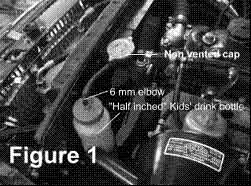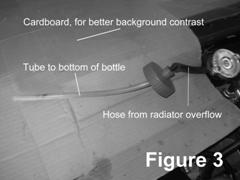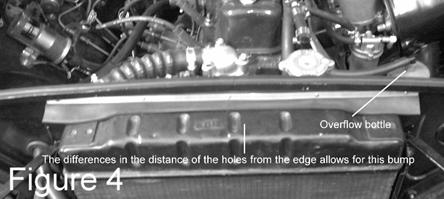by Herb Adler 5243 3409
As the BB is now registered and on the road, the SAGA will be about improvements, fiddling and fine adjustments more so than trying to get it to work.
My first improvement is to the
COOLING SYSTEM.
 I kept topping up the radiator, only to find that after a run it was low again. Turns
out that this is normal, you can't really tell how much coolant is in the radiator
because it overflows any “excess”. So I resolved to solve this, by installing an
overflow catch system. It consisted of a bicycle drink bottle and holder, purchased
from Kmart for around $9. Unfortunately the bottle was BLACK. However, I
pinched one of the kids' translucent drink bottles, in exchange for the black one, fig
1.
I kept topping up the radiator, only to find that after a run it was low again. Turns
out that this is normal, you can't really tell how much coolant is in the radiator
because it overflows any “excess”. So I resolved to solve this, by installing an
overflow catch system. It consisted of a bicycle drink bottle and holder, purchased
from Kmart for around $9. Unfortunately the bottle was BLACK. However, I
pinched one of the kids' translucent drink bottles, in exchange for the black one, fig
1.

 By removing the centre radiator mounting bolt, on the passenger side of the car and
drilling two holes to suit the holder, above and below this bolt, and mounting the
drink bottle holder, I effectively supported the radiator and the holder. I also needed
to trim a bit off the air intake tube, so that it would clear the bottle, as in fig 2 .
By removing the centre radiator mounting bolt, on the passenger side of the car and
drilling two holes to suit the holder, above and below this bolt, and mounting the
drink bottle holder, I effectively supported the radiator and the holder. I also needed
to trim a bit off the air intake tube, so that it would clear the bottle, as in fig 2 .
With the bottle I physically mangled the lid by extracting that funny pop up, pop
down valve and fitting a 6mm elbow, with a piece of plastic tubing, as shown in fig
3.
To finish this I replaced the standard unsealed radiator cap with a sealed one,
Tridon part number CA0750, so that any overflow would actually wind up in the
bottle.
 The next thing I did was to minimise the amount of air flow from the rear of the
radiator to the front, as in Fig 4, which improves the cooling effect, since hot air is
stopped from recirculating around the radiator.
The next thing I did was to minimise the amount of air flow from the rear of the
radiator to the front, as in Fig 4, which improves the cooling effect, since hot air is
stopped from recirculating around the radiator.
 Figure 5 shows the dimensions of the aluminium and rubber strips. The aluminium
strip is 518 X 10 X 3 mm, whilst the rubber strip is 518 X 27 X 7mm, available
from Clark's rubber, in High St, Belmont. The difference in how deep into the
rubber strip the holes are punched is for the “bump” in the radiator. The whole
assembly was attached with 1/8” screws and nuts, using the aluminium strip, as a
drilling guide in the radiator bulkhead.
Figure 5 shows the dimensions of the aluminium and rubber strips. The aluminium
strip is 518 X 10 X 3 mm, whilst the rubber strip is 518 X 27 X 7mm, available
from Clark's rubber, in High St, Belmont. The difference in how deep into the
rubber strip the holes are punched is for the “bump” in the radiator. The whole
assembly was attached with 1/8” screws and nuts, using the aluminium strip, as a
drilling guide in the radiator bulkhead.
